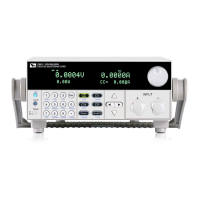Remote Control
Copyright © ITECH Electronic Co., Ltd. 8
Message Unit Separator
When two or more message units are combined into a compound message,
separate the units with a semicolon (STATus:OPERation?;QUEStionable?).
Root Specifier
When it precedes the first header of a message unit, the colon becomes the
root specifier. It tells the command parser that this is the root or the top node of
the command tree.
Message Terminator
A terminator informs SCPI that it has reached the end of a message. Three
permitted message terminators are:
newline (<NL>),decimal 10 or hexadecimal 0X0A in ASCII.
end or identify (<END>)
both of the above (<NL><END>).
In the examples of this guide, there is an assumed message terminator at the
end of each message.
Command execution rules
Commands execute in the order that they are presented in the program
message.
An invalid command generates an error and, of course, is not executed.
Valid commands that precede an invalid command in a multiple command
program message are executed.
Valid commands that follow an invalid command in a multiple command
program message are ignored.
1.8 SCPI Command Complete
SCPI commands sent to the electronic load are processed either sequentially
or in parallel. Sequential commands finish execution before a subsequent
command begins. Parallel commands allow other commands to begin
executing while the parallel command is still executing. Commands that affect
trigger actions are among the parallel commands.
*WAI, *OPC, and *OPC:Common commands provide different ways of
indicating when all transmitted commands, including any parallel ones, have
completed their operations. Some practical considerations for using these
commands are as follows:
*WAI: This prevents the electronic load from processing subsequent commands
until all pending operations are completed.
*OPC?: This places a 1 in the Output Queue when all pending operations have
completed. Because it requires your program to read the returned value before
executing the next program statement, *OPC? can be used to cause the
controller to wait for commands to complete before proceeding with its
program.
*OPC: This sets the OPC status bit when all pending operations have
completed. Since your program can read this status bit on an interrupt basis,
*OPC allows subsequent commands to be executed.
Note
The trigger system must be in the Idle state in order for the status OPC bit to be true.

